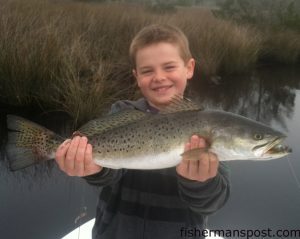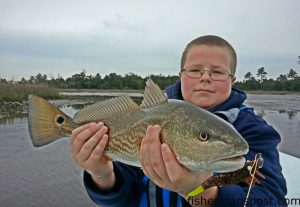Swansboro March 28, 2013

Evan Sewell with a fat speckeld trout he hooked on his birthday while fishing the White Oak River with his father, Capt. Chris Sewell of Fishead Charter. A soft plastic bait fooled the big trout.
Rob, of Sandbar Safari Charters, reports that anglers are finding some solid schools of red drum working in the Swansboro-area backwaters. The bays with soft, muddy bottoms offer the best odds of finding some feeding fish, as the darker bottoms hold the sun’s heat and warm up the water a bit. Slowly working Gulp baits on light jigheads or fishing cut mullet or live mud minnows on Carolina rigs has been the best bet to hook up with the reds recently.
Speckled trout are feeding in the creeks off the rivers and mainland side of the ICW recently (with good numbers in the 2-4 lb. range). The high, falling tides have been offering the most consistent fishing, and anglers are hooking the fish on Gulp baits and suspending shrimp imitations. Like the reds, fishing slow has been key to success with the specks.
Anglers are already catching some sea mullet from the surf and pier, and it won’t be long until they make their way inshore, along with good numbers of gray trout. Deeper channels near the inlet and off the ICW and the area around the Swansboro waterfront are where to find the grays and mullet. Soft plastic grubs and diamond jigs are top baits for the grays, and spec rigs tipped with shrimp or Fish Bites will attract attention from both tasty bottom feeders.
Out in the ocean, some schools of false albacore have been working bait, and they’ll move closer to the beaches as the water warms a few degrees.
Flounder should also be starting to show up on the nearshore wrecks, ledges, and live bottoms. Anglers can tempt the flatfish to bite 2 oz. bucktail jigs tipped with Gulp baits.
Robbie, of Hall’Em In Charters, reports that, for March, the speckled trout fishing is as good as it gets, with anglers putting together east limits most days (of 18-24” fish). The specks are looking for meals in the creeks and rivers, and darker water areas seem to be the most productive. Many are feeding in deeper holes near the bends of channels; however, the fish seem to be scattered throughout the creeks, so covering some ground on the trolling motor is a good idea. A variety of artificials have been tempting bites from the trout, including Betts Halo Shad, Storm shrimp, soft plastic jerkbaits, and MR17 MirrOlures (especially in the 808 and EC colors).

Wes Holder with a red drum he landed on his 13th birthday. The red fell for a D.O.A. shrimp on a spinnerbait while he was fishing some backwaters near Swansboro with Capt. John Mauser of Tailing Tide Guide Service.
Red drum are schooling up in the local marshes, with most fish on the lower end of the slot limits, but some schools of larger fish in the mix as well. The winds have made sight-fishing for the reds tough lately, but on calm days they’ve been easy to find. Gulp baits fished slowly have been fooling most of the reds recently.
Anglers are already starting to hook some flounder while working 2 oz. bucktails around structure in the 10-15 mile range, and the fish will only move closer to the beaches as the nearshore water temperatures climb over the coming weeks.
Rich, of The Reel Outdoors, reports that anglers are beginning to connect with some pufferfish and sea mullet in the surf and from the pier. Most are falling for shrimp on double-drop bottom rigs.
Speckled trout, red drum, and a few flounder are feeding in the area’s inshore creeks. A few specks and reds have already taken an interest in topwater plugs this season, but soft plastics and suspending lures like MirrOlure MR17’s are a safer bet until the water temps rise a bit more.
Some flounder are feeding at structure off Bogue Inlet already. Anglers willing to put some time in should be able to put a few in the boat, although they’ll have to weed through big numbers of black sea bass to do so.
Out in the Gulf Stream, wahoo, blackfin tuna, and perhaps some yellowfin tuna should be available to boats trolling skirted ballyhoo in early April. The Swansboro Hole and Rise are two excellent spots to begin hunting for the blue water gamefish.
Mike, of Bogue Inlet Pier, reports that anglers are connecting with some pufferfish and sea mullet while bottom fishing with shrimp and other baits from the pier (with good numbers of both to around 1 lb.).
The sea mullet and puffer bite will only get better as the water temperature rises over the coming weeks, and anglers may also encounter some black and red drum, smaller bluefish, or spot.





